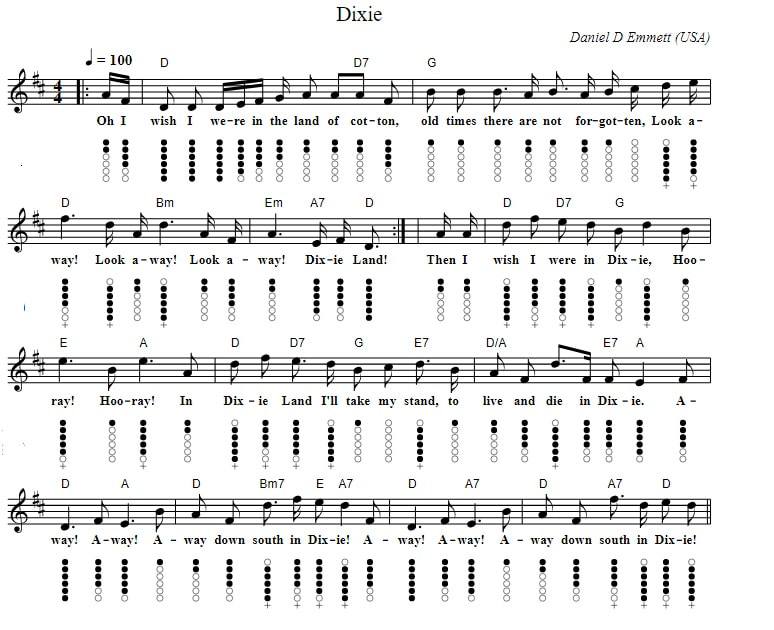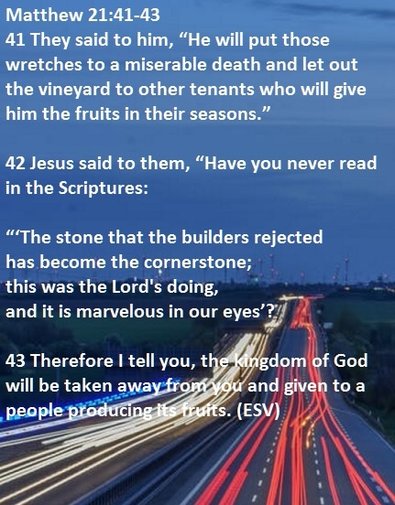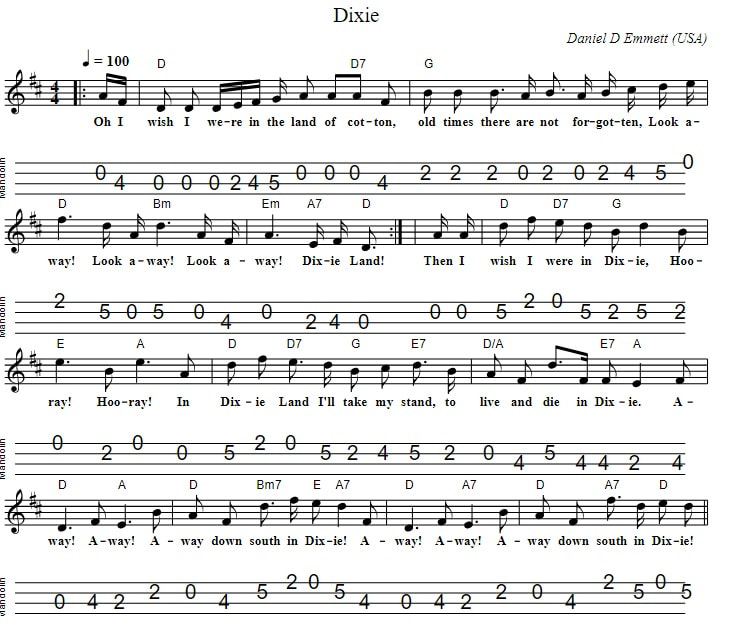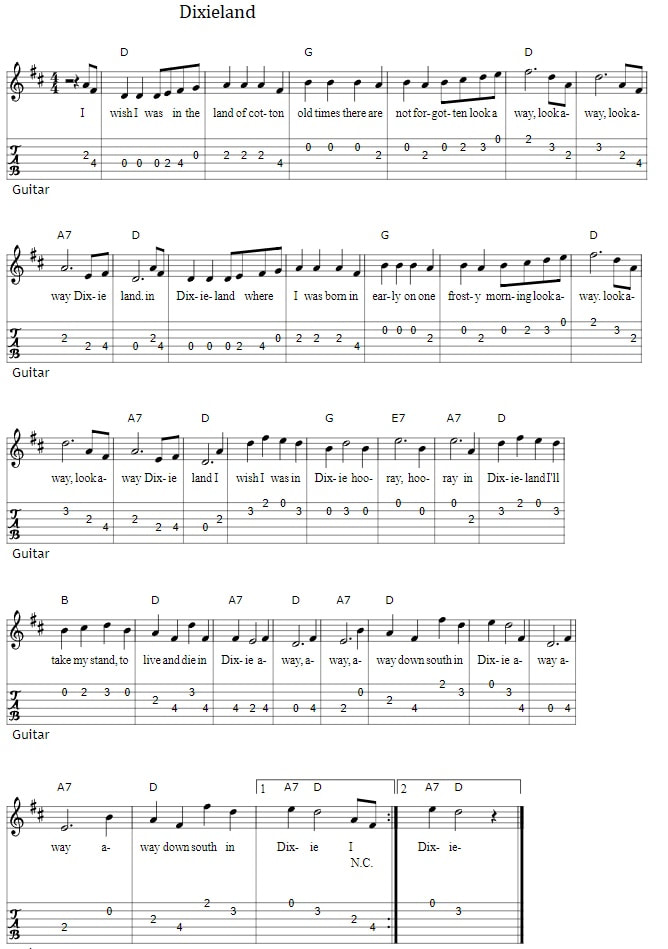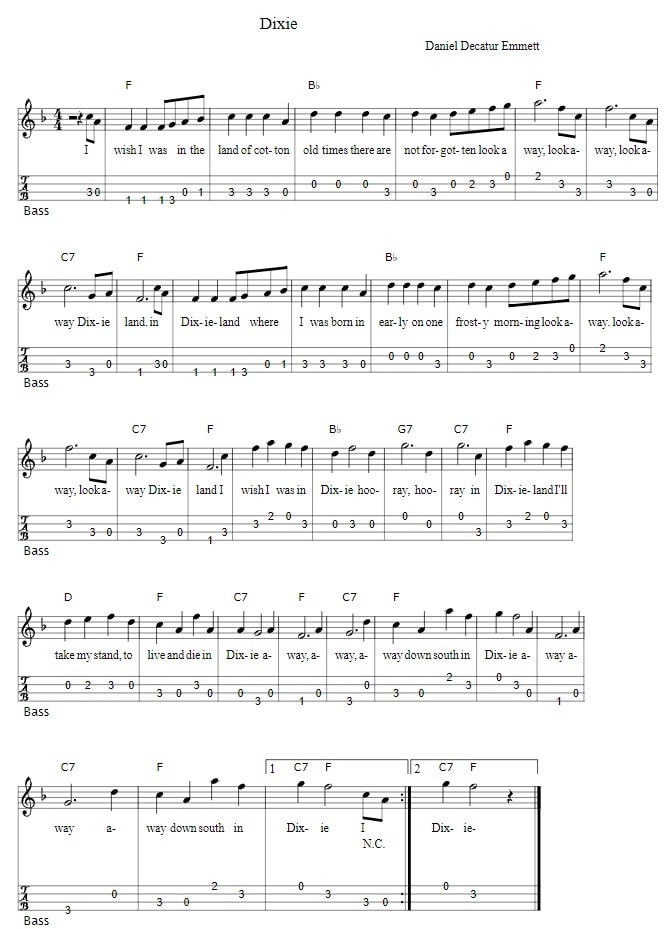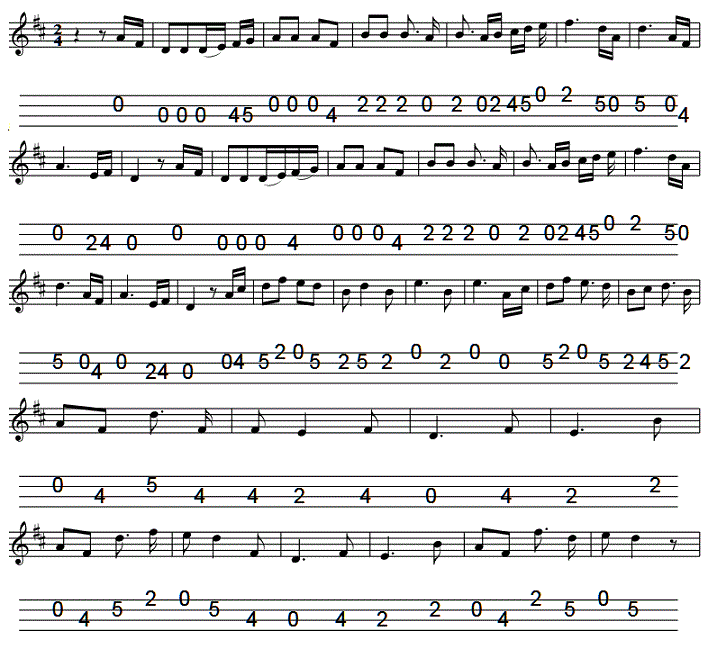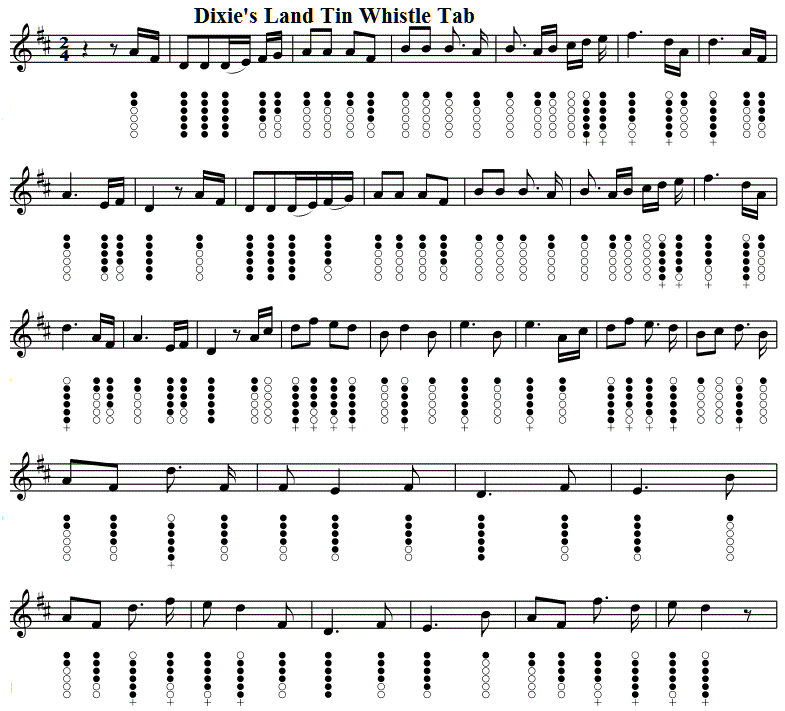Dixie's Land Lyrics Chords And Sheet Music
4/4 (1859, Lyrics: Daniel Decatur Emmett)[ Tin whistle and mandolin / banjo sheet music included. Key of D. along with the 5 string banjo chords] The fingerstyle guitar and bass tabs included.
More American Patriot Song Lyrics And Chords .
More American Patriot Song Lyrics And Chords .
I (D)wish I was in the land of cotton,
(G)Old times dar am not forgotten,
Look a(D)way! Look away! Look a(A)way! Dixie (D)Land.
In (D)Dixie Land whar' I was born in,
(G)Early on one frosty mornin',
Look a(D)way! Look away! Look a(A)way! Dixie (D)Land.
Chorus
Den I (D)wish I was in (G)Dixie, Hoo-(Em)ray! Hoo-(A)ray!
In (D)Dixie land, I'll (G)take my stand to (D)live and die in (A)Dixie;
A(D)way, a(A)way, a(D)way down south in Dixie,
A(D)way, a(A)way, a(D)way down south in Dixie.
Old (D)Missus marry Will-de-weaber,
(G)Willium was a gay deceaber;
Look a(D)way! Look away! Look a(A)way! Dixie (D)Land.
But (D)when he put his arm around 'er
(G)Smiled as fierce as a forty-pounder,
Look a(D)way! Look away! Look a(A)way! Dixie (D)Land.
Chorus
His (D)face was sharp as a butcher's cleaver,
But (G)dat did not seem to greab 'er;
Look a(D)way! Look away! Look a(A)way! Dixie (D)Land.
Old (D)Missus acted the foolish part,
And (G)died for a man dat broke her heart,
Look a(D)way! Look away! Look a(A)way! Dixie (D)Land.
Chorus
Now (D)here's a health to the next old Missus,
And (G)all the gals dat want to kiss us;
Look a(D)way! Look away! Look a(A)way! Dixie (D)Land.
But (D)if you want to drive 'way sorrow,
(G)Come and hear dis song to-morrow,
Look a(D)way! Look away! Look a(A)way! Dixie (D)Land.
Chorus
Dar's (D)buckwheat cakes an' Injun batter,
(G)Makes you fat or a little fatter;
Look a(D)way! Look away! Look a(A)way! Dixie (D)Land.
Den (D)hoe it down and scratch your grabble,
To (G)Dixie's land I'm bound to trabble,
Look a(D)way! Look away! Look a(A)way! Dixie (D)Land.
Chorus
The Star Spangled Banner Sheet Music Notes are also here.
(G)Old times dar am not forgotten,
Look a(D)way! Look away! Look a(A)way! Dixie (D)Land.
In (D)Dixie Land whar' I was born in,
(G)Early on one frosty mornin',
Look a(D)way! Look away! Look a(A)way! Dixie (D)Land.
Chorus
Den I (D)wish I was in (G)Dixie, Hoo-(Em)ray! Hoo-(A)ray!
In (D)Dixie land, I'll (G)take my stand to (D)live and die in (A)Dixie;
A(D)way, a(A)way, a(D)way down south in Dixie,
A(D)way, a(A)way, a(D)way down south in Dixie.
Old (D)Missus marry Will-de-weaber,
(G)Willium was a gay deceaber;
Look a(D)way! Look away! Look a(A)way! Dixie (D)Land.
But (D)when he put his arm around 'er
(G)Smiled as fierce as a forty-pounder,
Look a(D)way! Look away! Look a(A)way! Dixie (D)Land.
Chorus
His (D)face was sharp as a butcher's cleaver,
But (G)dat did not seem to greab 'er;
Look a(D)way! Look away! Look a(A)way! Dixie (D)Land.
Old (D)Missus acted the foolish part,
And (G)died for a man dat broke her heart,
Look a(D)way! Look away! Look a(A)way! Dixie (D)Land.
Chorus
Now (D)here's a health to the next old Missus,
And (G)all the gals dat want to kiss us;
Look a(D)way! Look away! Look a(A)way! Dixie (D)Land.
But (D)if you want to drive 'way sorrow,
(G)Come and hear dis song to-morrow,
Look a(D)way! Look away! Look a(A)way! Dixie (D)Land.
Chorus
Dar's (D)buckwheat cakes an' Injun batter,
(G)Makes you fat or a little fatter;
Look a(D)way! Look away! Look a(A)way! Dixie (D)Land.
Den (D)hoe it down and scratch your grabble,
To (G)Dixie's land I'm bound to trabble,
Look a(D)way! Look away! Look a(A)way! Dixie (D)Land.
Chorus
The Star Spangled Banner Sheet Music Notes are also here.
Dixieland music is a genre of jazz that originated in the early 20th century in the Southern United States, particularly in the city of New Orleans. It is a vibrant and energetic style of music that is characterized by its use of lively rhythms, improvised solos, and collective improvisation. The roots of Dixieland can be traced back to the fusion of African rhythms and European musical traditions, which created a unique and distinctly American sound.
The term 'Dixieland' itself has a complex history, with various interpretations and connotations. Some believe it refers to the Mason-Dixon line, which historically separated the Northern and Southern states in the United States. Others associate it with the song 'Dixie,' a popular tune during the American Civil War that was adopted as the unofficial anthem of the Confederacy. However, the most widely accepted theory is that it comes from the French word 'dixie,' which was a ten-dollar bill issued by the Citizens' Bank of New Orleans in the 19th century. This currency featured the French word 'dix' for ten, hence the term 'Dixieland.'
The origins of Dixieland music can be traced back to the early 1900s, where it emerged from the fusion of African American and European musical traditions in the city of New Orleans. New Orleans was a melting pot of cultures, with a diverse population of African Americans, European Americans, and Creoles. The city's vibrant music scene was a result of this cultural mix, with musicians from different backgrounds coming together to create a new and unique sound.
Dixieland was initially played by small ensembles known as 'jazz bands,' which consisted of a trumpet, clarinet, trombone, piano, drums, and a banjo or guitar. These bands played in bars, clubs, and street parades, entertaining audiences with their lively and energetic music. The style of music was heavily influenced by traditional New Orleans brass bands, with the addition of the piano and banjo, which added a distinctive rhythm and harmony to the music.
One of the key elements of Dixieland music is its emphasis on collective improvisation. Unlike other jazz genres, where the focus is often on individual solos, Dixieland is characterized by all the instruments playing together in a coordinated and improvised manner. This creates a sense of unity and energy among the musicians, which is reflected in the music and is a defining feature of the genre.
Another important aspect of Dixieland music is its use of call-and-response patterns. This technique involves one musician playing a phrase or melody, and the others responding with a variation or a counter-melody. This call-and-response structure is deeply rooted in African musical traditions and adds a unique flavor to Dixieland music.
One of the most iconic and influential figures in Dixieland music is Louis Armstrong, also known as 'Satchmo.' Armstrong, a native of New Orleans, was a prolific trumpeter, singer, and bandleader who helped popularize the genre and spread it beyond its Southern roots. His distinctive, gravelly voice and innovative trumpet playing style revolutionized Dixieland and jazz music as a whole.
Dixieland music gained widespread popularity in the 1920s and 1930s, known as the 'Jazz Age.' It was a time of cultural and artistic transformation, with jazz music becoming the soundtrack of the era. The rise of radio and recording technology helped spread Dixieland music across the country, and it became a staple in dance halls, speakeasies, and nightclubs.
Despite its popularity, Dixieland faced criticism from some who viewed it as a 'primitive' and 'lowbrow' form of music, especially in comparison to other jazz genres like swing and bebop. However, its influence on these genres cannot be denied, and many jazz musicians, including some of the greats like Duke Ellington and Benny Goodman, were heavily influenced by Dixieland.
Today, Dixieland music continues to thrive and evolve, with many jazz enthusiasts and musicians keeping the spirit of the genre alive. It has also influenced other musical genres, such as rock and roll, and continues to be a source of inspiration for artists from all over the world.
In conclusion, Dixieland music is a unique and significant genre that represents the cultural fusion and creativity of the American South. Its lively rhythms, collective improvisation, and call-and-response patterns make it a vibrant and energetic style of music that has stood the test of time. Its influence on jazz and other musical genres is undeniable, and it continues to be a beloved and celebrated genre among music lovers worldwide.
The term 'Dixieland' itself has a complex history, with various interpretations and connotations. Some believe it refers to the Mason-Dixon line, which historically separated the Northern and Southern states in the United States. Others associate it with the song 'Dixie,' a popular tune during the American Civil War that was adopted as the unofficial anthem of the Confederacy. However, the most widely accepted theory is that it comes from the French word 'dixie,' which was a ten-dollar bill issued by the Citizens' Bank of New Orleans in the 19th century. This currency featured the French word 'dix' for ten, hence the term 'Dixieland.'
The origins of Dixieland music can be traced back to the early 1900s, where it emerged from the fusion of African American and European musical traditions in the city of New Orleans. New Orleans was a melting pot of cultures, with a diverse population of African Americans, European Americans, and Creoles. The city's vibrant music scene was a result of this cultural mix, with musicians from different backgrounds coming together to create a new and unique sound.
Dixieland was initially played by small ensembles known as 'jazz bands,' which consisted of a trumpet, clarinet, trombone, piano, drums, and a banjo or guitar. These bands played in bars, clubs, and street parades, entertaining audiences with their lively and energetic music. The style of music was heavily influenced by traditional New Orleans brass bands, with the addition of the piano and banjo, which added a distinctive rhythm and harmony to the music.
One of the key elements of Dixieland music is its emphasis on collective improvisation. Unlike other jazz genres, where the focus is often on individual solos, Dixieland is characterized by all the instruments playing together in a coordinated and improvised manner. This creates a sense of unity and energy among the musicians, which is reflected in the music and is a defining feature of the genre.
Another important aspect of Dixieland music is its use of call-and-response patterns. This technique involves one musician playing a phrase or melody, and the others responding with a variation or a counter-melody. This call-and-response structure is deeply rooted in African musical traditions and adds a unique flavor to Dixieland music.
One of the most iconic and influential figures in Dixieland music is Louis Armstrong, also known as 'Satchmo.' Armstrong, a native of New Orleans, was a prolific trumpeter, singer, and bandleader who helped popularize the genre and spread it beyond its Southern roots. His distinctive, gravelly voice and innovative trumpet playing style revolutionized Dixieland and jazz music as a whole.
Dixieland music gained widespread popularity in the 1920s and 1930s, known as the 'Jazz Age.' It was a time of cultural and artistic transformation, with jazz music becoming the soundtrack of the era. The rise of radio and recording technology helped spread Dixieland music across the country, and it became a staple in dance halls, speakeasies, and nightclubs.
Despite its popularity, Dixieland faced criticism from some who viewed it as a 'primitive' and 'lowbrow' form of music, especially in comparison to other jazz genres like swing and bebop. However, its influence on these genres cannot be denied, and many jazz musicians, including some of the greats like Duke Ellington and Benny Goodman, were heavily influenced by Dixieland.
Today, Dixieland music continues to thrive and evolve, with many jazz enthusiasts and musicians keeping the spirit of the genre alive. It has also influenced other musical genres, such as rock and roll, and continues to be a source of inspiration for artists from all over the world.
In conclusion, Dixieland music is a unique and significant genre that represents the cultural fusion and creativity of the American South. Its lively rhythms, collective improvisation, and call-and-response patterns make it a vibrant and energetic style of music that has stood the test of time. Its influence on jazz and other musical genres is undeniable, and it continues to be a beloved and celebrated genre among music lovers worldwide.
Mandolin tab
Here are the guitar chords for the key of G Major.
I (G)wish I was in the land of cotton,
(C)Old times dar am not forgotten,
Look a(G)way! Look away! Look a(D)way! Dixie (G)Land.
In (G)Dixie Land whar' I was born in,
(C)Early on one frosty mornin',
Look a(G)way! Look away! Look a(D)way! Dixie (G)Land.
Chorus
Den I (G)wish I was in (C)Dixie, Hoo-(Am)ray! Hoo-(D)ray!
In (G)Dixie land, I'll (C)take my stand to (G)live and die in (D)Dixie;
A(G)way, a(D)way, a(G)way down south in Dixie,
A(G)way, a(D)way, a(G)way down south in Dixie.
Key of C Major.
I (C)wish I was in the land of cotton,
(F)Old times dar am not forgotten,
Look a(C)way! Look away! Look a(G)way! Dixie (C)Land.
In (C)Dixie Land whar' I was born in,
(F)Early on one frosty mornin',
Look a(C)way! Look away! Look a(G)way! Dixie (C)Land.
Chorus
Den I (C)wish I was in (F)Dixie, Hoo-(Dm)ray! Hoo-(G)ray!
In (C)Dixie land, I'll (F)take my stand to (C)live and die in (G)Dixie;
A(C)way, a(G)way, a(C)way down south in Dixie,
A(C)way, a(G)way, a(C)way down south in Dixie.
I (G)wish I was in the land of cotton,
(C)Old times dar am not forgotten,
Look a(G)way! Look away! Look a(D)way! Dixie (G)Land.
In (G)Dixie Land whar' I was born in,
(C)Early on one frosty mornin',
Look a(G)way! Look away! Look a(D)way! Dixie (G)Land.
Chorus
Den I (G)wish I was in (C)Dixie, Hoo-(Am)ray! Hoo-(D)ray!
In (G)Dixie land, I'll (C)take my stand to (G)live and die in (D)Dixie;
A(G)way, a(D)way, a(G)way down south in Dixie,
A(G)way, a(D)way, a(G)way down south in Dixie.
Key of C Major.
I (C)wish I was in the land of cotton,
(F)Old times dar am not forgotten,
Look a(C)way! Look away! Look a(G)way! Dixie (C)Land.
In (C)Dixie Land whar' I was born in,
(F)Early on one frosty mornin',
Look a(C)way! Look away! Look a(G)way! Dixie (C)Land.
Chorus
Den I (C)wish I was in (F)Dixie, Hoo-(Dm)ray! Hoo-(G)ray!
In (C)Dixie land, I'll (F)take my stand to (C)live and die in (G)Dixie;
A(C)way, a(G)way, a(C)way down south in Dixie,
A(C)way, a(G)way, a(C)way down south in Dixie.
